Cell phone inventor to address the tower workers who installed the backbone for the “Brick”
By Craig Lekutis
June 29, 2013 – The first message sent in American Morse Code by Samuel Morse to officially open the Baltimore-Washington telegraph line on May 24, 1844 was “What 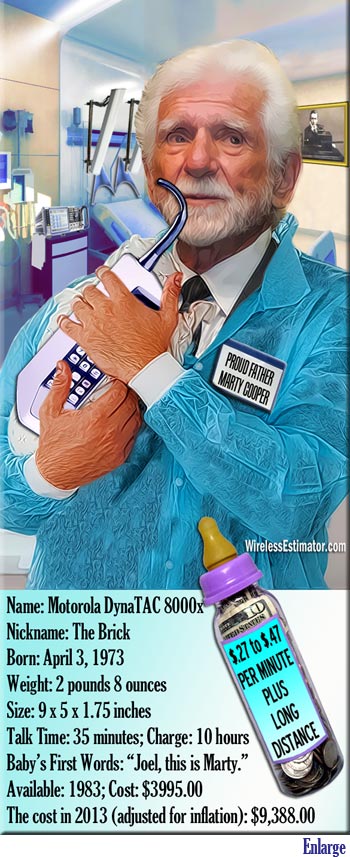 hath God wrought.” hath God wrought.”
When Martin “Marty” Cooper of Motorola, world-recognized inventor of the portable cell phone, made his first mobile phone call to razz his archcompetitor, Bell Labs’ Joel Engel, to let him know that he had lost the handheld mobile phone race, he started with: “Joel, this is Marty Cooper.”
Since that April 3, 1973 Manhattan, N.Y. call it appears that it might have been more appropriate for his lead engineer, Donald Linder, to have called then FCC Chairman Dean Burch and ask, “What has Marty wrought?”
What Cooper helped shape was a nation addicted to their cell phones and other wireless devices where individuals of all ages start jonesing if their phone’s battery is south of 30% capacity and there is no immediate fix.
He also helped set the path for multi-billion dollar enterprises and a continuing increase in worldwide GDP growth and personal productivity, lessening of world poverty and health problems, and other global achievements that would make industrialists like Eli Whitney blush with envy.
And two weeks ago President Obama issued a directive for the country to immediately move forward in researching, testing and implementing spectrum sharing, although the nation was given that wake-up call by Cooper more than 20 years ago.
Following Cooper’s first call, due to glacial speed FCC rule making, administration objections and lawsuits, it would be another 10 years before Motorola commercially introduced its first handheld phone, the DynaTAC8000x, nicknamed the ”Brick,” at a handsome price of $3,995.
Adjusted for inflation, today that phone with a talk time of 35 minutes requiring 10 hours for a full charge would cost $9,388.
By 1998, the cellular products group that Cooper had managed before he left Motorola in 1983 had grown to provide 42% of Motorola's $30 billion in revenue.
The FCC approved commercial cell phones on a regular basis starting in 1982, and by 1984 there were 91,600 cell phone users, many of them proudly sporting the DynaTAC.
But in the ensuing years, appreciable increases in portable phone sales for Motorola, Nokia and other manufacturers were dependent upon contractors building out the first analog and 2G networks to handle the pent-up demand for mobility without painful pricing.
Cooper will meet many of those men and women when he provides the keynote speech at the National Association of Tower Erectors’ annual conference, NATE UNITE 2014, to be held in San Diego, Calif., Feb. 24-27, 2014.
Expected profits mired by Japan’s phone dumping
As expected, due partially to the DynaTAC phone, revenues rose rapidly in 1984 for Motorola as systems began to operate in additional U.S. cities, but their cellular operating losses increased considerably.
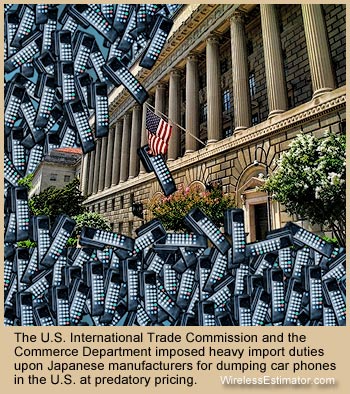 It was a year in which 36% of sales came from its communications division and revenues were $5.5 billion. It was a year in which 36% of sales came from its communications division and revenues were $5.5 billion.
Licensing and construction permits were delayed in several major markets, and Japanese-manufactured car phones were, according to Motorola, being sold at predatory pricing and cut into their earnings.
Motorola filed an antidumping petition with the U.S. International Trade Commission and the Commerce Department. The agencies agreed with the Schaumburg, Ill. company’s assertions.
The highest import duty, 106.6%, was imposed against Matsushita (now Panasonic), the giant of the Japanese consumer electronics industry, which was selling its phones in the U.S. at less than half of their prices in Japan.
Cellular car phones were selling in Japan for more than $2,000, but the same products, according to Motorola, were sold in the U.S. at wholesale prices of less than $1,500 and in some cases less than $1,000.
Japanese companies charged with dumping were Fujitsu, Hitachi, JRC, Kokusai, Matsushita, Mitsubishi, NEC, Oki and Toshiba.
Neither Bell nor other U.S. cell phone manufacturers supported Motorola in its petition to the ITC, but the ITC lauded Motorola, stating their actions should benefit the entire U.S. cellular phone manufacturing industry, which at that time employed approximately 1,100 workers.
When the Bell System was ready for their trial launch in Chicago in 1975, they put out a bid for 135 cell phones and selected Japanese company Oki Electric which provided pricing at one-third of Motorola’s bid.
At that time, Motorola captured almost two-thirds of all U.S. mobile communications revenues.
Motorola said that Oki’s bid was being subsidized by the Japanese government.
It was the first and extremely smart phone group
Subscribers swelled to an unbelievable 1.3 million in 1987 as contractors and site acquisition personnel worked at a fevered pitch to build out the nation’s networks.
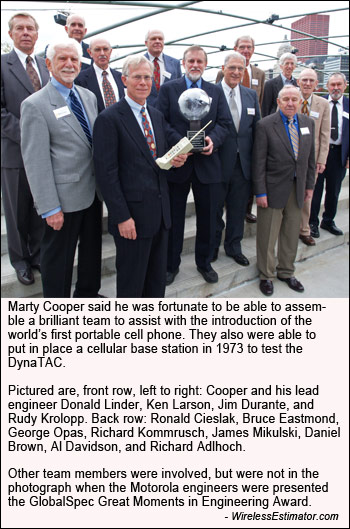 Motorola was the clear leader in mobile phone sales during the early years of cellular, but DynaTAC’s sales, although in the many hundreds each year, weren’t overly impressive due to its cost and its inability to obtain a signal, especially inside a building. Motorola was the clear leader in mobile phone sales during the early years of cellular, but DynaTAC’s sales, although in the many hundreds each year, weren’t overly impressive due to its cost and its inability to obtain a signal, especially inside a building.
But tower crews helped solve that problem as they built the necessary cell sites required for portable mobile service, and in 1989, Motorola introduced its highly desirable MicroTAC, weighing in at 12.3 ounces with a slim battery, and an even slimmer price of $2,300.
Since then, Motorola’s mobile phone sales have dropped considerably, especially in the smartphone market where Apple continues to lead with a 39% share while Motorola is fourth of the big five with 8.3%, according to comScore.
Last year smartphones represented only 18% of total global handsets in use, according to Cisco.
Cooper lays claim to the first truly smart idea for a portable phone he introduced over 40 years ago which used a then-staggering two thousand transistors in a nine-inch phone, whereas in today’s phones it’s measured in hundreds of millions.
“There was also a medium scale microprocessor - used for the synthesizer - and several small scale I.C.s,” Cooper told Wireless Estimator during one of a number of interviews.
“There were also lots of capacitors and coils and yet all the phone did was dial numbers; remember, 10 numbers, and ring on reception of the phone’s number,” he said.
A modern smartphone can contain over 200 million transistors, but more importantly, the core microprocessor can run at over a GHz, perhaps a hundred times faster than chips just ten years ago, according to Cooper.
Although Cooper and his team are well-known for inventing the phone, they’re oftentimes not recognized for engineering and building the prototype base station and later patenting that cellular radio system.
Cooper’s inspiration was entrenched long before Star Trek
Popular and Wikipedia lore has it that if it wasn’t for Captain Kirk using his 1964 Communicator flip phone-like device, the cell phone might not have been invented by 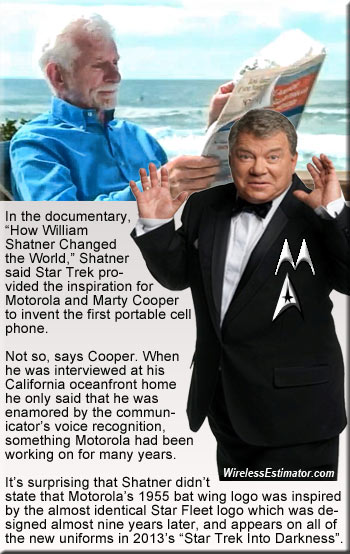 Cooper’s group. Cooper’s group.
But Cooper says Dick Tracy’s 1946 two-way wrist radio was one of a number of seminal triggers for his inspiration, not Star Trek.
“I have been a science fiction addict since that genre existed, back to Jules Verne. And before that I was into fantasy and mythology,” he said.
“The idea of personal communicators took hold way before Star Trek,” Cooper said.
In the 2005 Discovery Channel documentary, “How William Shatner Changed the World,” Shatner says Gene Roddenberry’s Star Trek inspired many people in the real world to invent technological advancements.
He charted almost every invention other than monoclonal gene splicing.
After Cooper was interviewed in his Del Mar, Calif. oceanfront home, Shatner said in a voiceover, “Thanks to Star Trek, Marty and Motorola had the inspiration they needed to build a telephone that had mobility.”
Even if they had sensitive Vulcan hearing, viewers of the humor-laden documentary would be hard-pressed to hear Cooper give credit to Star Trek for the DynaTAC.
He did state in his segment, however, that he was enamored by voice recognition.
Cooper: “And suddenly, there was Captain Kirk talking on his communicator; talking with no dialing. That was not a fantasy to us, although to the rest of the world it was. But to me that was an objective.”
Cooper said he couldn’t even imagine how many additional transistors would have been required then if voice recognition such as today’s Siri or Nina were available for his DynaTAC.
“Sorry, Craig! If it’s not wireless I’m pretty stupid,” he joked, with a reply to an email that he generated by “writing” with Dragon Naturally Speaking.
Cooper said his research labs at Motorola were demonstrating voice recognition in the late 1960s.
“It was still primitive, required training, and was very susceptible to ambient noise, but it worked. All we needed was somewhat more powerful processors and slightly better algorithms. It’s revealing that it took more than 40 years to get to really practical speech recognition for consumers,” Cooper said.
In 1988, Motorola developed that microprocessor capability and introduced their Digital Voice Caller model that enabled a motorist to make a call without touching the handset.
Today’s smart phones from Motorola have great voice recognition capabilities other than simply dialing, as well as one of their newest recognition features – using a biometric fingerprint sensor for security.
Shatner did not return a call from Wireless Estimator to find out if it was inspired by Star Trek’s multifunction tricorder.
Motorola’s drive kept AT&T from having another monopoly
Gordon Gekko, in the movie Wall Street, advanced the DynaTAC’s popularity even further.
Gekko, played by Michael Douglas, appeared to have had the DynaTAC surgically attached to his jutting jaw throughout the film as he made deals, called his mistress and proselytized that “Greed, for the lack of a better word, is good.”
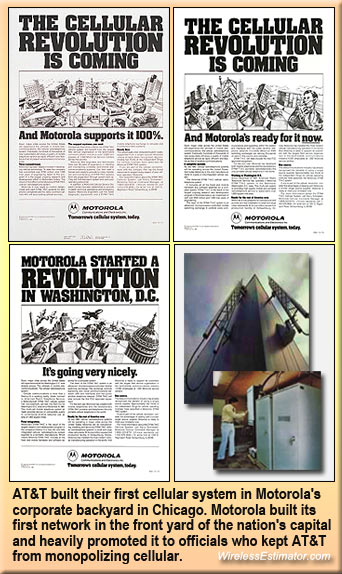 But it was AT&T’s greed which forced Motorola to invent the cell phone along with a base station to keep AT&T’s Bell telephone companies from monopolizing the proposed cellular system conceived and invented by Douglas H. Ring of Bell Telephone Laboratories in 1947. But it was AT&T’s greed which forced Motorola to invent the cell phone along with a base station to keep AT&T’s Bell telephone companies from monopolizing the proposed cellular system conceived and invented by Douglas H. Ring of Bell Telephone Laboratories in 1947.
In 1970, the FCC allocated 75 MHz to AT&T’s cellular concept for them to test the system within 18 months, and in 1971 Bell Labs said that in Newark, N.J. and Philadelphia, Pa. they were able to show that cell-splitting was feasible with cells whose radii were as small as 1.4 miles.
According to Engel, who ran the program, in a 2009 video interview he said that Bell made this request to the FCC: “If at the end of 18 months if we have a satisfactory answer we want assurance from you that you’ll give us the frequencies.”
He didn’t state whether the agency agreed, but unofficially, the FCC let it be known that they did, and only telephone companies would be allowed to operate cellular networks since cellular service was just an adjunct of their current business.
AT&T’s lobbyists continued to develop that posture, stating that only Bell Labs had the technical ability to roll out a cell system in every city in the country and that the company should be able to recoup their considerable investment in inventing and testing cellular communications.
Engel said in the video interview: “We were the only horse they could bet on.”
The FCC let the Bell System begin a trial in 1975. Two years later the agency approved AT&T’s request to actually operate their trial cellular system.
AT&T seen as a threat to consumers and businesses
Although Motorola had been supplying the Bell System with radiotelephones for decades, the company saw AT&T’s cavalier comments and the FCC’s direction as threats to their commercial two-way radio and paging business products in their 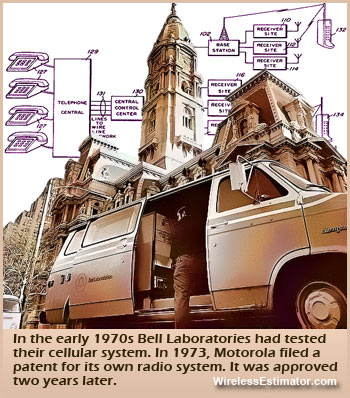 communications division. communications division.
Motorola was alarmed that it would cripple many licensed radio common carriers who used their hardware and software-based products such as taxicab and delivery companies.
They also saw it as the death knell for paging if cellular technologies became cheaper and more widely available. At that time there were approximately 50 million people using pagers.
Cooper was also concerned that AT&T would only have car phones when they implemented cellular.
In 1973, Motorola filed a patent for its own cellular radio system. It was approved two years later.
“We at Motorola reacted just as your constituents in the tower business would,” Cooper said. “They would have been relegated to captive vendors serving one customer. We were also certain that the customer need was personal phones, not car phones.”
Cooper said that at the time Motorola was a “tiny company” compared to AT&T.
Years later, Engel disagreed, stating that AT&T recognized Motorola as “the IBM” of the communications equipment industry.
Engel’s belief in 1971: “You had to do it from a car and the engine had to be running.”
“I suggested in November of 1972 that we build and demonstrate a real cell phone. I collected a variety of technology from my brilliant colleagues and invented Motorola’s version of cellular technology,” Cooper said.
“I then assembled an equally brilliant team who designed and built the phone and the supporting infrastructure in three months so we could demonstrate the importance of our concepts to the decision makers and to the rest of the world.”
In order to meet that ambitious 90-day deadline, Cooper said the project became a top priority within Motorola.
"We essentially shut down all of our project engineering in the company and everybody virtually worked on that system during the first months of 1973," Cooper said.
Having invested more than $100 million over ten years for the prototype system, it was now time for Motorola’s most pivotal dog and pony show in the history of the company.
Motorola's engineers and technicians assembled impressive looking vans with high tech cellular equipment and parked them outside of the Watergate Hotel in Washington. After listening to a rather absorbing story about the new DynaTAC system, senators, congressmen, and FCC commissioners were driven in the vans and Motorola demonstrated that they could clearly do land mobile at 900 MHz.
“People were dazzled,” Cooper said, never realizing that they were being driven through carefully planned routes to ensure that there were no dropped calls.
Cooper can’t remember any complimentary comments that were made that day due to what he called the phobic nature of Motorola’s leadership team.
“We were paranoid. So if anybody said anything good we would ignore it. We were only looking for the bad stuff.”
“We would go to conferences with product sheets of products that we hadn’t yet created, just in case our competitors came out with something new so we would be able to counter whatever they had.”
“We were worried right up until the time the FCC actually made their announcement that they were going to have competition. We had no feeling of confidence,” Cooper said.
Demos caught the attention of the DOJ
The Washington and New York demonstrations captured the imagination of people everywhere and it appears to have influenced the regulatory decision process. Engel says he’s certain it set back the introduction of cellular for many years.
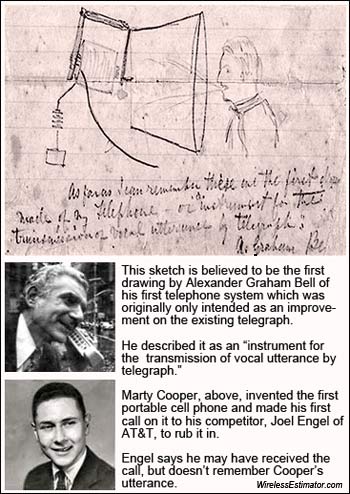 It certainly caught the attention of the Department of Justice which argued against letting only the telephone companies into the cellular business, believing that in order to protect their wireline business they would stymie growth and prevent the alternative communications networks from competing with their established service. It certainly caught the attention of the Department of Justice which argued against letting only the telephone companies into the cellular business, believing that in order to protect their wireline business they would stymie growth and prevent the alternative communications networks from competing with their established service.
The RCCs informed the DOJ that if they weren’t allowed to participate, the telephone companies would expand into the mobile communications industry which was currently being served by numerous competitive businesses, and they would resort to predatory competition.
It took until 1981 before the FCC compromised and decided to allow two cellular systems in each geographic area. One would be operated by an affiliate of the telephone company, acting independently, and the other would be from a competing pool of applicants wanting the wireless franchise.
To Motorola’s benefit, the FCC also said that The Bell System could manufacture cellular telephones, but they could not require that customers of their wireless services use them.
After the FCC made its final decision on spectrum for cellular systems in 1982, in 1983 Ameritech Mobile Communications (Chicago), a division of Ameritech, which was the holding company of numerous Bell telephone operating companies, and Cellular One (Washington, D.C.) became the first operational commercial cellular providers in the U.S.
Ameritech’s cellular system was AMPS, Advanced Mobile Phone Service developed from the AT&T model; Cellular One used Motorola’s DynaTAC system. Those systems were quickly installed and operating within three years in each of the nation’s 90 largest markets.
Cellular One was founded by Walter Lohr who headed American Radio Telephone, the paging company that was selected by Motorola to operate the trial cellular service in Washington.
But when it came time to bid for the Washington license in 1982, Schelle got cold feet, reportedly because he didn’t think cellular was ever going to be profitable and didn’t want to invest his money.
Motorola easily twisted his arm by financing his cellular network. Schelle later sold Cellular One to Metromedia and became quite wealthy. Metromedia then sold out to Southwestern Bell in 1987.
“Without the inspiration and the strong support of management, portable handsets would not have appeared on the market until much later than it happened,” Cooper said, who then served as Motorola’s communications operations vice president.
“My friends at Bell Labs believe that cellular would have happened sooner without Motorola’s intervention. They are probably right, but car telephones would not have been very exciting, nor would they have created the revolution that handheld portable phones did,” said Cooper.
From 1984 to 1985 subscribers more than tripled to 340,213 and doubled again in 1986 to 681,825 and again in 1987 to 1,300,855, according to CTIA. At the end of 2012, the trade group said wireless subscribers of active smartphones, feature phones, tablets and other devices totaled 326.4 million.
Chicago police system assisted cellular’s first portable mobile phone
In 1967, Cooper delivered the first handheld police radios in Chicago. He said that DynaTAC’s quick introduction was assisted by selected technology introduced into the 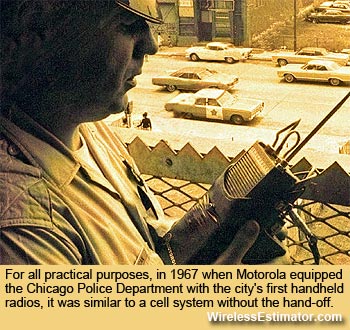 new handheld radio. new handheld radio.
“We were experimenting with 1 GHz portable two-way radios even when we were telling the FCC that 1 GHz was impractical for mobile use and that we needed more 150 MHz and 450 MHz frequencies.”
“And we were trying to build synthesizers out of microprocessors that were still experimental because we knew that future mobiles would need them. But we had never made a synthesizer with 666 channels before. The housing, circuit boards, duplexers, etc. were all custom-built,” Cooper said.
He noted that the Chicago police system was, for all practical purposes, a cell system.
“We didn’t have hand-off, but didn’t need it since police messages averaged 15 seconds for an entire conversation,” Cooper said.
The one-watt portable was designed after the Chicago Police Department’s police commissioner had contacted Motorola and said he wanted his police to be on the beat with people instead of trapped in their cars. Once they got in their cars they became isolated from their constituencies, he said.
Cooper said that the concept of personal portable communication was learned over many years of observing customers and people, but Chicago’s police request was when he really made the discovery that is his mantra today: “People are Mobile.”
“They are naturally, inherently mobile. You can observe this on your local expressway. It seems that nobody is where they want to be, everyone is going somewhere else. In World War II, Motorola made walkie-talkies and observed how soldiers became dependent on them.”
“In the 50s and 60s, we made the “Handie-Talkie” hand held version. We saw, for example, a New York messenger making a few dollars an hour riding a twenty dollar bicycle and carrying a thousand dollar two-way radio, which multiplied his efficiency, his ability to serve his customers, by many times,” Cooper explained.
Popular Science hails Cooper’s DynaTAC system as “amazing”
In 1973, when you would only be able to find Gizmodo if they were your first seven Scrabble tiles, and when The New York Times technology columnist David Pogue was in the sixth grade, possibly writing a book report on The Best of Isaac Asimov, the go-to publication for 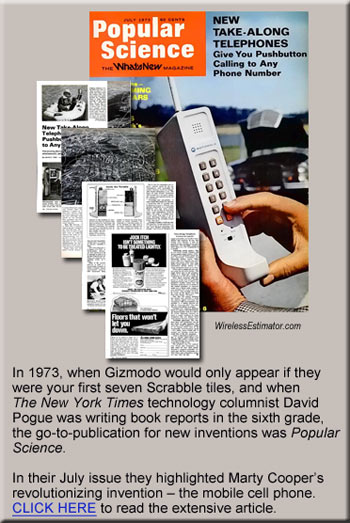 new inventions was Popular Science. new inventions was Popular Science.
In their July issue they highlighted Cooper’s revolutionizing invention – the mobile cell phone. They labeled it as “amazing.”
The article, as stated in Motorola’s press release, said that with FCC approval New York City could have a Motorola cellular system operating by 1976. But lawsuits and a recalcitrant FCC kept that from happening until approval came years later.
In a prophetic statement in a closing paragraph, author John R. Free said, “Eventually the unit could fit your shirt pocket.”
Today, however, small isn’t a priority in the exhibition hall, but thin is in. Motorola’s Droid RAZR thin phone measures in at slightly more than one-quarter of an inch.
Earlier this year, Samsung unveiled a prototype of its first phone using a flexible almost paper-thin display that could be rolled up like a map and stored.
LG Display is banking on flexible displays being the new frontier for electronics and announced this month that they will begin mass producing them in the fourth quarter of this year.
Cooper said he tries out multiple phones every year, but he wouldn’t use any cell phone with less than a four-inch screen.
From boom to almost bust to boom again
Although Cooper and Motorola clearly paved the way for competitive cellular services, the FCC believed that a duopoly wasn’t in America’s best interest and they allocated 143 MHz of spectrum, almost triple the spectrum allocated to cellular service, to create Personal Communications Services (PCS) in 1995.
 At the time they said it would provide at least three to six new competitors to the cellular carriers in each market. They also found that they had a cash cow with their license auctions. At the time they said it would provide at least three to six new competitors to the cellular carriers in each market. They also found that they had a cash cow with their license auctions.
The country’s vertical realtors, contractors, and other infrastructure providers also found profitable opportunities, but whereas cellular allowed them to print money, as PCS matured it provided limited bundling of dollars as carriers crunched the numbers and brought profit margins down, especially in construction, to single digit levels.
AT&T, whose turf vendor driver pricing, requiring yearly reductions, was seen as the carrier that took the greatest advantage of companies that would have to shutter their businesses if they didn’t accept the offered contracts.
Cooper, an evangelist for competition, has been a long-time critic of the carrier, and was thoroughly against the AT&T / T-Mobile merger.
He was relieved to see the Department of Justice’s required breakup of the Bell System in 1982 when AT&T was forced to relinquish control, but is now concerned that they’re heading back to monopoly status.
The solid push to roll out Long Term Evolution (LTE), the 4G standard which allows for high-speed data, began in 2010 and today it has created such a workforce shortfall that hiring bonuses are eclipsing early PCS levels and OEMs are starting focus groups to identify ways that they can bring qualified personnel into the market.
For workers, the acronym is also identified as Long Term Employment. For many contractors, it’s Love Those Earnings as they again get to bring home some broadband bacon.
Will prosperity keep growing with LTE or Faux 5G?
Industry observers believe that the LTE buildout will provide a minimum of three to four years of steady infrastructure growth for wireless contractors.
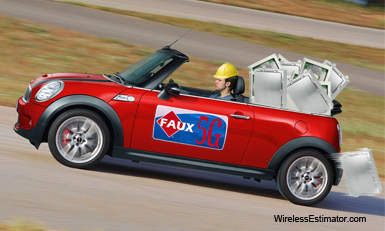 Samsung has piqued considerable industry interest with their recently announced plans for 5G, but Cooper says that these are still early days to be talking about a fifth generation. Samsung has piqued considerable industry interest with their recently announced plans for 5G, but Cooper says that these are still early days to be talking about a fifth generation.
Samsung’s version of 5G is at 28 GHz and would be useful only in dense urban areas, with spacing at .3 miles or less, Cooper said.
“Actually, these are even early days for 4G since there will be more advanced versions of 4G coming out for years. The big issue with 4G in the near future will be MIMO and smart antennas. This will mean more tower loading at some point,” he said.
Samsung said their 5G technology, technology that has to be controlled by a standards organization, not a manufacturer, could be ready in seven years.
Huawei, expecting data demands to increase 1,000-fold in the next 10 years, is also studying and conducting field trials of 5G data transfer technology.
If it’s introduced, it appears that the installation requirements will be minimal and contractors will only be required to have a Mini-Cooper to deliver two dozen transmitters and receivers to their wall mount locations.
A Samsung test engineer said that the prototype wireless link could reach 656 feet even when there was no direct line-of-sight.
Seeking the silver bullet for the spectrum solution
There is no silver bullet for the spectrum crunch, but Cooper believes that technologists will solve the problem and the data choke can be relieved without additional spectrum being awarded.
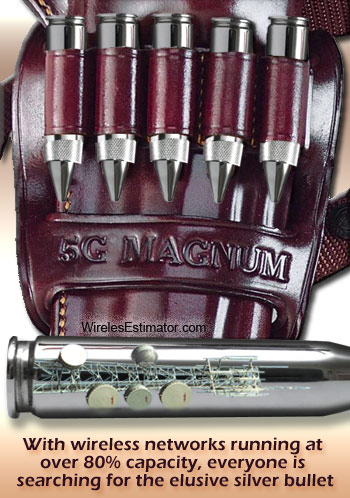 A number of analysts believe that the purported spectrum shortage is a convenient argument for carriers looking to line their spectrum coffers. A number of analysts believe that the purported spectrum shortage is a convenient argument for carriers looking to line their spectrum coffers.
It became a rallying cry of carriers earlier this year for the FCC to license more spectrum when Cisco said (see report) that mobile traffic could possibly increase 13-fold by 2017.
Cooper proposes – as the FCC gets ready to auction off 600 MHz licenses – that there isn’t a scarcity of spectrum and never will be one.
Cooper relies upon his observation, dubbed “Cooper’s Law” of spectral efficiency, to identify how technological improvements have provided and will continue to provide advanced personal communications without additional spectrum.
He identifies that in a comparison of “conversations” (voice or data) that can be conducted over a given area in all of the useful radio spectrum, the number has doubled every two-and-a-half years for the past 104 years, from when Guglielmo Marconi conducted his first transmissions in 1895 through 1999.
Cooper further points out that the cumulative improvement in the effectiveness of personal communications total spectrum utilization has been over a trillion times in the last 90 years, and a million times in the last 45 years.
Almost 95% of those improvements were a result of spectrum re-use, confining individual conversations to smaller and smaller areas.
And the good news, Cooper says, there is no such limitation on re-use of radio spectrum and the cost to send data will continue to go down.
A presidential advisory committee last year urged President Obama to adopt computer technologies so that better usage is made of spectrum for wireless communications.
He agreed, and on June 14 issued his directive as well as pledging $100 million in funding for spectrum sharing research and development.
Part of President Obama's initiative is to free-up wireless spectrum now being used by federal agencies so that it can be reallocated for private sector use
Former FCC Chairman Julius Genachowski was an advocate for reallocation of government spectrum, stating that it has about 60% of the most desirable spectrum.
But cutting off slices of spectrum is just part of the solution.
One developing technology which can help is called cognitive radio, in which cellphones scan for available frequencies and choose the best one to use.
An example that is frequently given is if the government has reserved some spectrum for use at an Air Force bombing range, but if no bombing is happening on a particular day, cognitive radio could allow a phone to sniff out for an open channel and switch to it.
Although carriers and industry engineers state that spectrum sharing technologies look promising, they say it’s not the solution to nurse America’s voracious data appetite.
Cooper sees "cognitive" as a red herring
Cooper believes that cognitive technology is at least 10 years away. Plus, he says, the term is misleading.
“The whole concept of cognitive radio is a red herring. The word  [cognitive] refers only to a tiny part of what has to be done to have complete – what we call - dynamic spectrum access,” Cooper said. [cognitive] refers only to a tiny part of what has to be done to have complete – what we call - dynamic spectrum access,” Cooper said.
“The objective is that any time you make a transaction on the spectrum, you ought to use only the bandwidth that you need, only the geographic area you want to cover, for only the time that you need it and within the optimal band.”
Cooper said if you could do that you would improve spectral efficiency by a trillion times.
“There would be no issue of spectral scarcity or anything of that nature.
“The real issue is that the FCC and Congress are not really motivating people to use spectral efficiency. They do the opposite.
“They auction off the spectrum, they make it desirable for somebody to spend money getting the license for the spectrum without enforcing the basic rule which is that spectrum is supposed to be used in the public interest.
“We own the spectrum rights, not the licensee.
“We’re providing essentially a monopoly to those people to license the spectrum. They use it whatever way they want . And the more spectrum they buy the less competition they have. So we’re actually encouraging people to use the spectrum less efficiently,” Cooper said.
Cooper said he believes the Obama administration’s repurposing of 500 MHz of spectrum is a band aid and he’s going to voice his concern in the next few weeks during an FCC summer lecture series.
“The bottom line is there is technology available today that could multiply the spectrum and reduce costs by four or five times and it’s not being used,” Cooper said.
Cooper is concerned that the industry is not even tapping into all of the benefits that can be provided by LTE.
The real advantages of LTE with regard to spectral efficiency and coverage will not be realized until future installations adopt multiple antenna systems, Cooper said.
“The first iterations of that technology may only use two antennas per sector per band but, in extreme installations, they will ultimately use as many as eight or more antennas,” he said.
Cooper says that when LTE gets a little more mature, there are going to be smart antennas on every cell site and in every phone.
Cooper questions why many countries have systems using smart antennas that are 20 times or more spectrum efficient, but carriers aren’t using them here.
The Marty Cooper you might not know
Martin Cooper was born on December 26, 1928 in Chicago, Ill., but he moved with his family back to Winnipeg, Canada where his Russian immigrant parents, Arthur and Mary, tried out their entrepreneurial skills, but they moved back around 1935 and started a door-to-door sales business in Chicago.
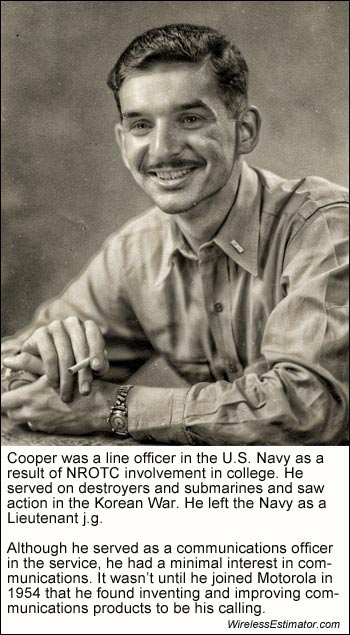 Cooper told Wireless Estimator that he didn’t get the opportunity to go to the Chicago World’s Fair in 1933 where AT&T’s exhibit reigned supreme and thousands of lucky visitors got to make their very first long distance call. Cooper told Wireless Estimator that he didn’t get the opportunity to go to the Chicago World’s Fair in 1933 where AT&T’s exhibit reigned supreme and thousands of lucky visitors got to make their very first long distance call.
Although that would surely have piqued his interest, everyday curiosities turned into a technical challenge for him.
At an early age he recalls seeing some older kids setting fire to a piece of paper with a magnifying glass. He then took the base of a broken bottle and couldn’t understand why he wasn’t able to get it to focus and burn the sun.
Fortunately for the world, by 1973 his achievement scorecard read: Solar System – 0; Cellular System -1.
Cooper has two children, but they didn’t follow his career path; his son is an attorney and his daughter became an accountant; his four grandchildren are far removed from the engineering field as well, opting for professions from a piano prodigy to a sportscaster.
Encouraged by his parents, Cooper said he was an avid reader and lived in a household with his younger brother, Will, where he was always surrounded by books.
Cooper, who had already made up his mind that he was going to be an engineer, was enrolled in Crane Technical Preparatory High School in Chicago.
The males-only school was tough, not in an academic sense, but it provided an oftentimes threatening environment.
Of a number of shops, Cooper recalls that there was a forge shop where some students made brass knuckles. But he said there were a number of other shops which taught him a lot about science.
In recent years, one student was fatally shot and another was severely beaten with a golf club inside the Jackson Blvd. co-ed school which has moved away from technical courses.
To attempt to quell the violence, Crane was invited to participate in the Txt2Tip program, through which students are encouraged to send anonymous text messages to police – on the latest model of their Cooper-inspired cell phone.
It was a financial struggle for Cooper to attend the Illinois Institute of Technology, but once he was enrolled in 1946 they introduced a Navy ROTC program which he joined and they paid most of his tuition expenses, at that time $256 per semester.
He received his bachelor’s degree in 1950, a master’s degree in 1957, and was awarded an honorary doctorate in 2004. He currently serves on IIT's Board of Trustees.
He is a member of the high IQ society, Mensa.
When Cooper graduated IIT he went into the Navy and served on destroyers for a couple of years and then on submarines.
“I think the Navy was really an essential part of what I am today,” Cooper said.
Cooper served during the Korean War in the Yellow Sea on the U.S.S. Cony and recalls blowing up North Korean bridges for six months, and becoming frustrated because they would frequently rebuild them during the night and they would have to return the next day and do it again.
Although he served as a communications officer he said he didn’t have much of an interest in communications.
“I have always been interested in anything technical, but my interest in communications didn't start until I joined Motorola in 1954,” Cooper said.
Prior to that employment he worked for Teletype Corporation which provided a communications device that, like a mechanical typewriter, gave news organizations breaking news as well as providing quasi-secure messages to businesses.
Cooper held numerous positions at Motorola and directed the introduction of paging products, two way radios and nationwide car phones with 12 channels.
He also recruited many of Motorola’s top engineers.
Cooper left Motorola in 1983 to start, with two partners - one of whom is now his wife, Arlene Harris, also an inventor and a very successful entrepreneur - a new company that built software and billing systems for the new cellular industry that began that year.
The company was very successful and was sold in 1986.
He and Arlene then formed ArrayComm in 1992, a company providing multi-antenna signal (MAS) processing software and physical layer solutions for WiMAX and LTE wireless infrastructure and client device applications.
Their software is deployed in more than 300,000 base stations worldwide.
The firm has over 40 engineers, engineers that will hopefully confirm that “Cooper’s Law” can be extrapolated for the next 104 years, and spectrum challenges will be solved by technologists.
Cooper said that Motorola’s belief was that, “Some day everybody in the world would have a cellular telephone. In fact, we had a joke that said, in the future when you were born you would be assigned a telephone number and if you didn’t answer the phone you were dead.”
I’ve put a reminder on my Outlook to call Marty in 2033. And I believe that he’ll be gracious enough to provide me with a follow-up interview using a 3D retractable serpent flex screen coupled with the latest 12G SD ear lobe stud, and discuss the newest mobile medical advancements that will allow us to touch base again many years later using the nation’s unlimited and underutilized spectrum.
Martin Cooper can be followed on Twitter: @martymobile
Wireless Estimator can be followed on Twitter: @wirelessest
Or on Facebook
|
The 2012 Cisco®Visual Networking Index
Global Mobile Data Traffic Forecast Update is part of the comprehensive Cisco VNI Forecast, an ongoing initiative to track and forecast the impact of visual networking applications on global networks.
Executive Summary
The Mobile Network in 2012
Global mobile data traffic grew 70 percent in 2012. Global mobile data traffic reached 885 petabytes per month at the end of 2012, up from 520 petabytes per month at the end of 2011.
Last year's mobile data traffic was nearly twelve times the size of the entire global Internet in 2000. Global mobile data traffic in 2012 (885 petabytes per month) was nearly twelve times greater than the total global Internet traffic in 2000 (75 petabytes per month).
Mobile video traffic exceeded 50 percent for the first time in 2012. Mobile video traffic was 51 percent of traffic by the end of 2012.
Mobile network connection speeds more than doubled in 2012. Globally, the average mobile network downstream speed in 2012 was 526 kilobits per second (kbps), up from 248 kbps in 2011. The average mobile network connection speed for smartphones in 2012 was 2,064 kbps, up from 1,211 kbps in 2011. The average mobile network connection speed for tablets in 2012 was 3,683 kbps, up from 2,030 kbps in 2011.
In 2012, a fourth-generation (4G) connection generated 19 times more traffic on average than a non-4G connection. Although 4G connections represent only 0.9 percent of mobile connections today, they already account for 14 percent of mobile data traffic.
The top 1 percent of mobile data subscribers generate 16 percent of mobile data traffic, down from 52 percent at the beginning of 2010. According to a mobile data usage study conducted by Cisco, mobile data traffic has evened out over the last year and is now lower than the 1:20 ratio that has been true of fixed networks for several years.
Average smartphone usage grew 81 percent in 2012. The average amount of traffic per smartphone in 2012 was 342 MB per month, up from 189 MB per month in 2011.
Smartphones represented only 18 percent of total global handsets in use in 2012, but represented 92 percent of total global handset traffic. In 2012, the typical smartphone generated 50 times more mobile data traffic (342 MB per month) than the typical basic-feature cell phone (which generated only 6.8 MB per month of mobile data traffic).
Globally, 33 percent of total mobile data traffic was offloaded onto the fixed network through Wi-Fi or femtocell in 2012. In 2012, 429 petabytes of mobile data traffic were offloaded onto the fixed network each month. Without offload, mobile data traffic would have grown 96 percent rather than 70 percent in 2012.
Android is now higher than iPhone levels of data use. By the end of 2012, average Android consumption exceeded average iPhone consumption in the United States and Western Europe.
In 2012, 14 percent of mobile devices and connections were potentially IPv6-capable. This estimate is based on network connection speed and OS capability.
In 2012, the number of mobile-connected tablets increased 2.5-fold to 36 million, and each tablet generated 2.4 times more traffic than the average smartphone. In 2012, mobile data traffic per tablet was 820 MB per month, compared to 342 MB per month per smartphone.
There were 161 million laptops on the mobile network in 2012, and each laptop generated 7 times more traffic than the average smartphone. Mobile data traffic per laptop was 2.5 GB per month in 2012, up 11 percent from 2.3 GB per month in 2011.
Nonsmartphone usage increased 35 percent to 6.8 MB per month in 2012, compared to 5.0 MB per month in 2011. Basic handsets still make up the vast majority of handsets on the network (82 percent).
The Mobile Network Through 2017
Mobile data traffic will reach the following milestones within the next five years. • Monthly global mobile data traffic will surpass 10 exabytes in 2017.
• The number of mobile-connected devices will exceed the world's population in 2013.
• The average mobile connection speed will surpass 1 Mbps in 2014.
• Due to increased usage on smartphones, handsets will exceed 50 percent of mobile data traffic in 2013.
• Monthly mobile tablet traffic will surpass 1 exabyte per month in 2017.
• Tablets will exceed 10 percent of global mobile data traffic in 2015.
Global mobile data traffic will increase 13-fold between 2012 and 2017. Mobile data traffic will grow at a compound annual growth rate (CAGR) of 66 percent from 2012 to 2017, reaching 11.2 exabytes per month by 2017.
By the end of 2013, the number of mobile-connected devices will exceed the number of people on earth, and by 2017 there will be nearly 1.4 mobile devices per capita. There will be over 10 billion mobile-connected devices in 2017, including machine-to-machine (M2M) modules-exceeding the world's population at that time (7.6 billion).
Mobile network connection speeds will increase 7-fold by 2017. The average mobile network connection speed (526 kbps in 2012) will exceed 3.9 megabits per second (Mbps) in 2017.
In 2017, 4G will be 10 percent of connections, but 45 percent of total traffic. In 2017, a 4G connection will generate 8 times more traffic on average than a non-4G connection.
By 2017, 41 percent of all global mobile devices and connections could potentially be capable of connecting to an IPv6 mobile network. Over 4.2 billion devices and connections will be IPv6-capable in 2017.
Two-thirds of the world's mobile data traffic will be video by 2017. Mobile video will increase 16-fold between 2012 and 2017, accounting for over 66 percent of total mobile data traffic by the end of the forecast period.
Mobile-connected tablets will generate more traffic in 2017 than the entire global mobile network in 2012. The amount of mobile data traffic generated by tablets in 2017 (1.3 exabytes per month) will be 1.5 times higher than the total amount of global mobile data traffic in 2012 (885 petabytes per month).
The average smartphone will generate 2.7 GB of traffic per month in 2017, an 8-fold increase over the 2012 average of 342 MB per month. Aggregate smartphone traffic in 2017 will be 19 times greater than it is today, with a CAGR of 81 percent.
By 2017, almost 21 exabytes of mobile data traffic will be offloaded to the fixed network by means of Wi-Fi devices and femtocells each month. Without Wi-Fi and femtocell offload, total mobile data traffic would grow at a CAGR of 74 percent between 2012 and 2017 (16-fold growth), instead of the projected CAGR of 66 percent (13-fold growth).
The Middle East and Africa will have the strongest mobile data traffic growth of any region at 77 percent CAGR. This region will be followed by Asia Pacific at 76 percent and Latin America at 67 percent.
For a comprehensive Global Mobile Data Traffic Forecast Update, 2012–2017, click here.
|